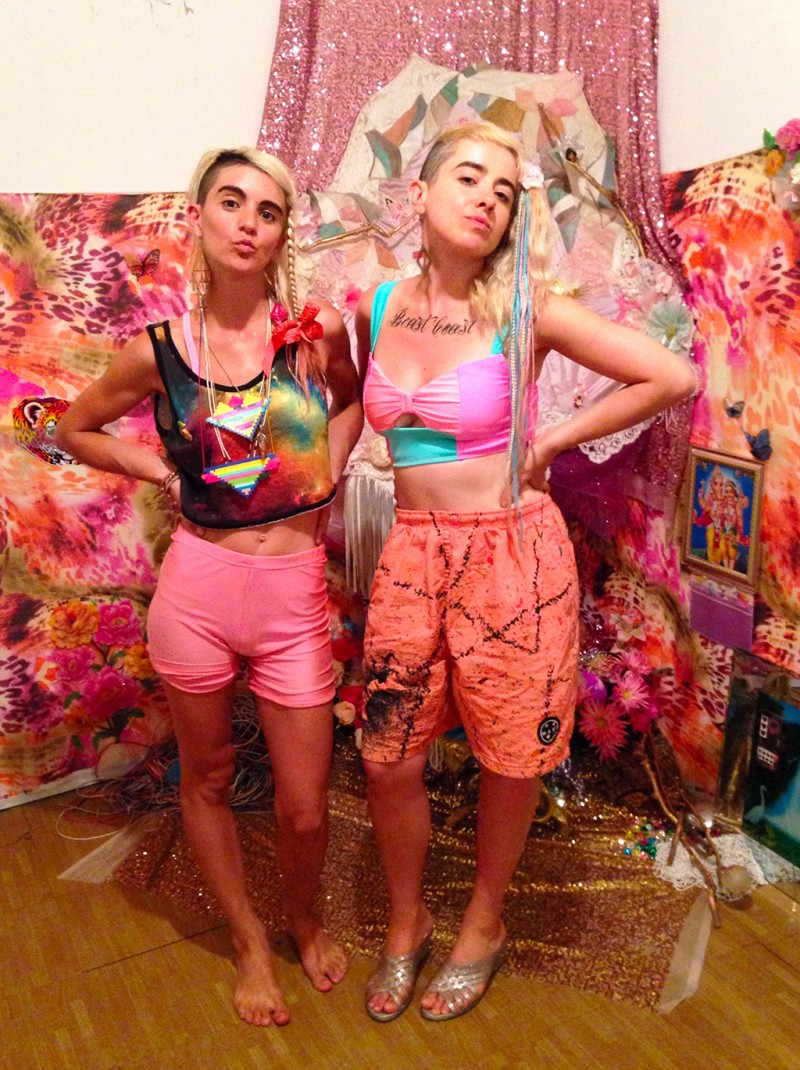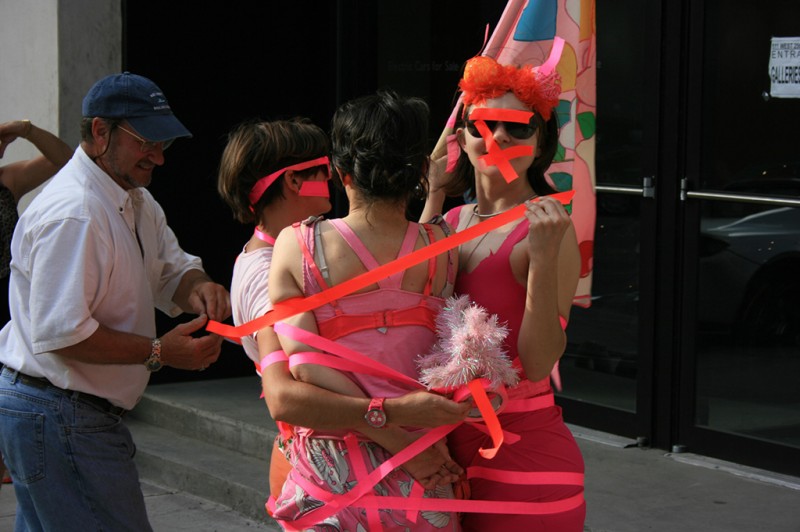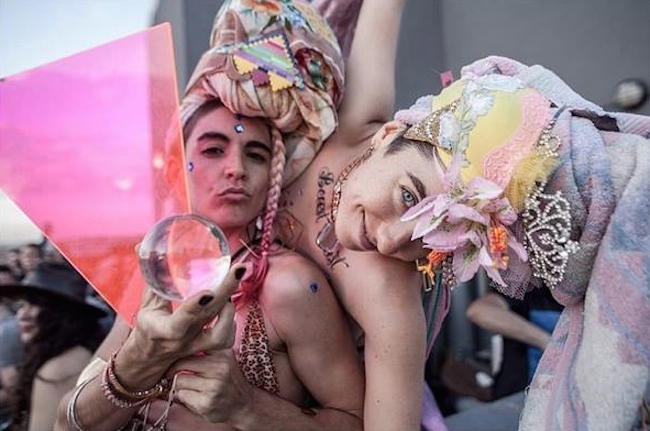
Go! Push Pops. The Clitney Perennial, a collective feminist performance protest at the Whitney Museum of American Art, New York, 2014. Courtesy Marie Tomanova.
I ventured uptown to the Whitney Museum of American Art two weekends before the closing of the 2014 Biennial. The exhibition spanned four floors and featured works from 103 participants selected by three curators. Strolling into the museum, I overheard one museum guard say to another, “Tonight’s protest should be fun.”
Beginning on the floor curated by Michelle Grabner, I worked my way down; there was no sign of a protest on the fourth or third floors. But the second floor, the work of Anthony Elms’s curatorial vision, was flooded with fake flowers and the scent of patchouli-tinged body odor. There, the protestors passed out brightly colored paper eyeglasses, resulting in audience members viewing their surroundings through the word cliteracy or cutout shapes that resembled both stylized eyes and upper vulva. The protesters at the “Clitney Perennial,” which included the radical feminist art collective, the Go! Push Pops, were expressing their stake in resetting the balance for underrepresented artists in New York City museums and galleries.
As the line between art and curation blurs, being tasked with selecting contemporary artists who fairly and accurately represent the zeitgeist is far from easy. Yet the Whitney, and its Biennial in particular, has repeatedly topped the offense list for numerous affronts related to inequality over the past several decades. In 1995, the Guerrilla Girls created the chart “Traditional Values and Quality Return to the Whitey [sic] Museum” that illustrates the breakdown of participants in Whitney shows by gender and ethnicity. This year’s Biennial was touted on the Whitney’s website as “one of the broadest and most diverse takes on art in the United States that the Whitney has offered in many years,” but Jillian Steinhauer of Hyperallergic provided statistics that tell a different story: 32 percent of the artists selected for the 2014 Biennial were female, and less than 8 percent were of African descent. Continuing its errors, the Whitney has followed the Biennial with a retrospective of the art world’s most flamboyant emblem of male whiteness: Jeff Koons.

Go! Push Pops in Katie Cercone’s studio, New York, 2014. Photo: Jacquelyn Gleisner.
Fast forward two months, and I am sitting on the floor of Katie Cercone’s Bushwick apartment and studio. Cercone and Elisa Garcia de la Huerta, cofounders of the Go! Push Pops, shared a pot of yerba mate tea on a purple yoga mat in front of one of Cercone’s elaborate altars of feminine detritus: sewn and stapled bathing suits and old trophies on a patchwork quilt hung on the wall.
The two met in New York in 2009 at the School of Visual Arts, where they had studios next to one another. Cercone had entered the graduate program by way of her feminist studies and liberal arts background at Scripps College in California and Lewis and Clark College in Oregon. Garcia de la Huerta, who grew up in Chile under a dictatorship, was trained in the fine arts at Finis Terrae University in Santiago. Their shared interest in crafts crystallized into a feminist collective called the Go! Push Pops, or simply the Push Pops, when they (along with another classmate who has since left the group) decided to dress head-to-toe in pink to see Portia Munson’s Pink Project in April 2010 at PPOW Gallery in Chelsea.

Go! Push Pops. Taped, a visit to Portia Munson’s Pink Project, PPOW Gallery, New York, 2010. Courtesy the artists. © Go! Push Pops
From its inception, the Push Pops has been devoted to updating the feminist messages of yore while relying heavily on popular references from both hip-hop and the aesthetic vernacular of twee culture. Cercone said, “Embodied feminism means honoring prior feminisms [while] making a departure from theory and language.” The portrayal of militant second-wave feminists by the media and slogans like “the personal is political” do not jive with a younger crowd whereas the products of Lisa Frank and Nicki Minaj do. In a recent workshop with at-risk youths, the Push Pops chose to connect the imagery of Beyoncé to ancient symbols of fertility and power, such as the Woman of Willendorf, instead of hypothesizing the negative repercussions of the pop icon’s brand of iconography. By fusing ancient symbols with current fetishes, like DIY and celebrity culture, the Go! Push Pops asserts a vision of feminism that resonates with contemporary society.

Go! Push Pops. Push Palmistry, 2014. Performance for Bushwick Open Studios, New York. Courtesy the artists. Courtesy Blonde Bundle.
The Push Pops’s neon paraphernalia at the “Clitney Perennial” and the faint scrim of glitter inside Cercone’s apartment evince an unquestioned embrace of the spectacle. Guy Debord made spectacle a dirty word in his 1967 text, The Society of the Spectacle, but the Push Pops updated the French philosopher’s view along with the maxims of that era’s feminism. Garcia de la Huerta explained that ritual and spectacle have never been enemies: “Things like glitter and jewelry,” she said, “have always been used by spiritual healers. We are creating work that visually represents a future of feminism as a form of healing. Young people are responding because this is something that they need.” Cercone stated, “The future of feminism is a blend of the past and the present. What we are striving for is a real sense of community. What binds a community together is its art, music, faith, and ritual. The Push Pops are a tool for creating that sense of togetherness.” Until these bonds exist, feminists and collectives such as the Go! Push Pops will continue to protest with rainbows, braids in their hair and hot-pink hearts, full of hope.
The Go Push Pops! will perform September 18, 2014, at Gitana Rosa Gallery in Chelsea. Katie Cercone and Elisa Garcia de la Huerta will also have works included in the gallery’s show, The New Bitch.



